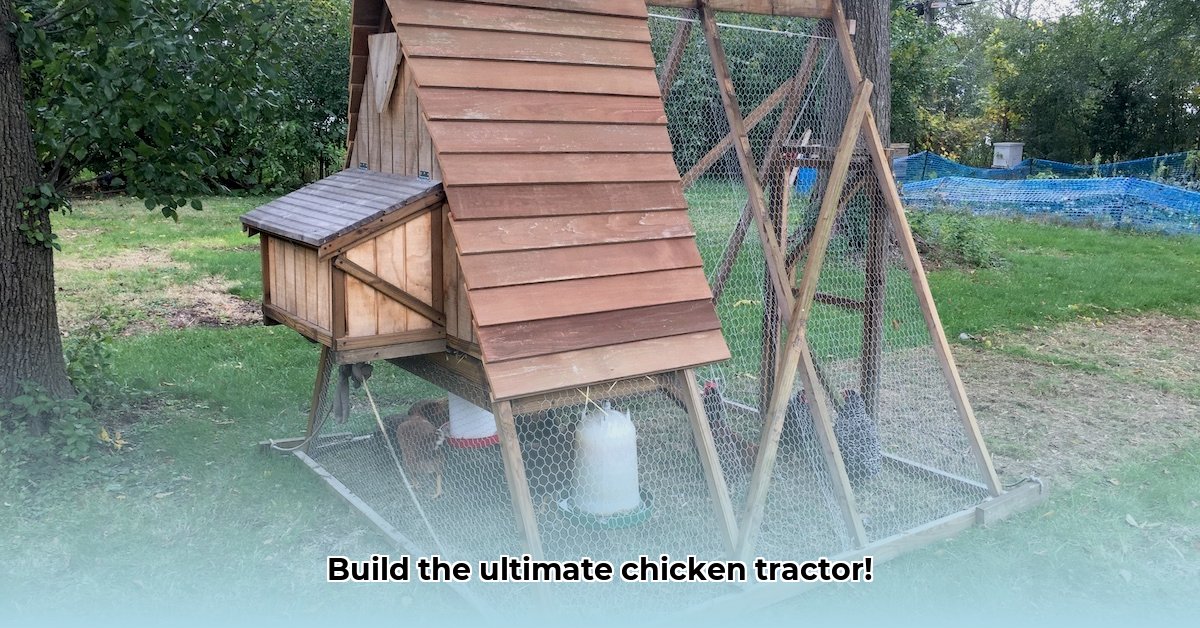
Ready to build the ultimate mobile chicken coop? An A-frame chicken tractor offers a fantastic way to provide your flock with fresh pasture daily, simplifying cleaning and promoting healthy chickens. This guide provides a step-by-step approach, comparing different designs and highlighting the popular Green Willow Homestead model. We'll cover predator protection, material selection, and essential construction techniques, ensuring you're fully equipped for success. For even more detailed plans, check out these easy chicken tractor plans.
Planning Your Chicken Tractor Build
Before you start hammering, consider these key planning factors:
Flock Size: How many chickens will call this tractor home? Overcrowding leads to stress and difficult cleaning. A larger flock requires a larger tractor.
Pasture Area: How much land will your tractor cover? This influences its size and maneuverability. Smaller yards need smaller, more easily moved tractors.
Predator Assessment: Identify local predators (foxes, raccoons, etc.). This guides your design's security features. A detailed assessment is crucial for effective protection.
DIY Skills: Are you a seasoned builder or a novice? Choose a design that aligns with your skill level. Simpler designs are ideal for beginners.
Budget: Set a clear budget. Materials can accumulate quickly! Comparing prices from different suppliers is recommended.
Comparing A-Frame Chicken Tractor Designs
Numerous A-frame designs exist, each with strengths and weaknesses. The Green Willow Homestead design is particularly popular for its robust build and excellent predator protection. However, simpler designs are quicker to build and require less initial investment.
Here's a comparison:
| Feature | Green Willow Homestead | Simpler Design |
|---|---|---|
| Build Time | Longer (Expect 2-3 days for experienced builders) | Shorter (1-2 days for experienced builders) |
| Durability | High (Expect 5+ years with proper maintenance) | Moderate (Expect 3-5 years with proper maintenance) |
| Predator Protection | Excellent (Galvanized steel mesh is often included) | Moderate (May require extra reinforcement like hardware cloth) |
| Cost | Higher (Expect to spend over $200 on materials) | Lower (Expect to spend under $150 on materials) |
| Mobility | Good (Usually features strong, easy-rolling wheels) | Varies (Dependent on wheel and design quality) |
| Manure Management | Often features enhanced drainage reducing pasture impact | Requires more frequent cleaning and pasture rotation |
"The choice depends on your priorities. Durability and robust predator protection are key for the Green Willow," says Sarah Miller, experienced homesteader and blogger at "Simply Sustainable Living."
Green Willow Homestead: A Detailed Analysis
The Green Willow Homestead design's popularity stems from its comprehensive approach to chicken keeping.
Pros:
Superior Predator Protection: Sturdy materials and reinforced mesh significantly reduce predation risk.
Enhanced Mobility: Well-designed wheels facilitate easy movement despite its size.
Exceptional Durability: Built to withstand years of use with minimal maintenance.
Effective Manure Management: Design features promote efficient manure dispersal.
Cons:
Increased Build Time: Requires more time and effort for construction.
Higher Initial Cost: Requires a substantial investment in materials upfront.
Simpler A-Frame Designs: A Quick and Budget-Friendly Option
Simpler designs offer speed and affordability, often using readily available materials.
Pros:
Lower Cost: Ideal for budget-conscious builders.
Rapid Construction: Quicker completion allows you to get your chickens housed faster.
Customization Potential: Simple designs are easy to adapt to your specific needs.
Cons:
Predator Vulnerability: Requires additional security measures like hardware cloth to prevent predators from entering.
Reduced Durability: May require more frequent repairs and maintenance.
Higher Maintenance: More frequent cleaning and pasture rotation may be necessary.
Step-by-Step Building Instructions (Simplified Example)
These steps are a basic outline. Adapt them according to your chosen design.
Gather Supplies: Lumber (pressure-treated recommended), wire mesh (galvanized for durability), hinges, wheels, screws, nails, roosting bar, etc.
Construct the A-Frame: Build a strong and stable structure. Accurate measurements are essential for success.
Secure Wire Mesh: Attach the mesh securely, ensuring no gaps that predators can exploit.
Install Wheels: Attach sturdy wheels that can handle the tractor's weight.
Add Roosting Bar: Install a roosting bar for comfortable chicken perching.
Weatherproofing: Apply a weather-resistant sealant. Proper sealing extends the life of the tractor significantly.
Material Selection: Prioritizing Quality
Choosing the right materials is crucial.
Lumber: Pressure-treated lumber resists rot, pests, and weather, providing long-term durability.
Wire Mesh: Galvanized hardware cloth (1/2 inch mesh minimum) prevents predator entry and is resistant to rust.
Hardware: High-quality hinges, latches, and screws maintain security and longevity.
Essential Tools
Ensure you have the necessary tools: measuring tape, saw, drill, screwdriver, wire cutters, hammer, and a level.
Choosing the Right Design for Predator Protection
A well-designed A-frame offers excellent predator protection. However, careful selection of materials and construction methods remains paramount.
Elevated Base: A raised base prevents digging predators from reaching your chickens.
Hardware Cloth: Use heavy-gauge hardware cloth for superior protection from small predators.
Door Security: Sturdy, well-fitting doors with strong latches are crucial.
Ground Anchoring: Securing your tractor to the ground adds another layer of security, particularly in high-predator areas.
Conclusion
Building your chicken tractor is a rewarding project! Choosing the right design ensures your chickens have a safe and comfortable home. Remember, proper planning and quality materials are key ingredients for a successful build.